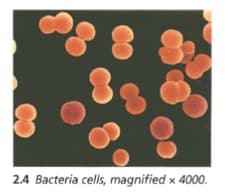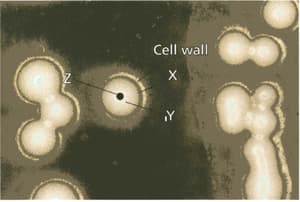EASY
Earn 100
Explain the purpose of using a microscope.
Important Questions on Conduct an investigation to provide evidence that living things are made of cells; either one cell or many different numbers and types of cells.
MEDIUM
Life Sciences>From Molecules to Organisms: Structures and Processes>Conduct an investigation to provide evidence that living things are made of cells; either one cell or many different numbers and types of cells.>Structure and Function - All living things are made up of cells, which is the smallest unit that can be said to be alive. An organism may consist of one single cell (unicellular) or many different numbers and types of cells (multicellular)
EASY
Life Sciences>From Molecules to Organisms: Structures and Processes>Conduct an investigation to provide evidence that living things are made of cells; either one cell or many different numbers and types of cells.>Structure and Function - All living things are made up of cells, which is the smallest unit that can be said to be alive. An organism may consist of one single cell (unicellular) or many different numbers and types of cells (multicellular)
Hubble telescope: high from earth surface:: Revolving orbit of Hubble telescope: _____. (high earth orbit/ low earth orbit)
MEDIUM
Life Sciences>From Molecules to Organisms: Structures and Processes>Conduct an investigation to provide evidence that living things are made of cells; either one cell or many different numbers and types of cells.>Structure and Function - All living things are made up of cells, which is the smallest unit that can be said to be alive. An organism may consist of one single cell (unicellular) or many different numbers and types of cells (multicellular)
a) Only components such as Temperature, water, light and soil.
b) Only components such as pathogens, parasites, predators and competitors of the organism with which they interact constantly.
c) The physiology and anatomy of organisms
d) Both a and b
EASY
Life Sciences>From Molecules to Organisms: Structures and Processes>Conduct an investigation to provide evidence that living things are made of cells; either one cell or many different numbers and types of cells.>Structure and Function - All living things are made up of cells, which is the smallest unit that can be said to be alive. An organism may consist of one single cell (unicellular) or many different numbers and types of cells (multicellular)
Discuss the action of a Bainbridge mass spectrometer to determine the isotopic masses.
EASY
Life Sciences>From Molecules to Organisms: Structures and Processes>Conduct an investigation to provide evidence that living things are made of cells; either one cell or many different numbers and types of cells.>Structure and Function - All living things are made up of cells, which is the smallest unit that can be said to be alive. An organism may consist of one single cell (unicellular) or many different numbers and types of cells (multicellular)
Mention any two achievements of Hubble Telescope.
MEDIUM
Life Sciences>From Molecules to Organisms: Structures and Processes>Conduct an investigation to provide evidence that living things are made of cells; either one cell or many different numbers and types of cells.>Structure and Function - All living things are made up of cells, which is the smallest unit that can be said to be alive. An organism may consist of one single cell (unicellular) or many different numbers and types of cells (multicellular)
Explain emission and absorption spectra ( Diagram not necessary)
MEDIUM
Life Sciences>From Molecules to Organisms: Structures and Processes>Conduct an investigation to provide evidence that living things are made of cells; either one cell or many different numbers and types of cells.>Structure and Function - All living things are made up of cells, which is the smallest unit that can be said to be alive. An organism may consist of one single cell (unicellular) or many different numbers and types of cells (multicellular)
EASY
Life Sciences>From Molecules to Organisms: Structures and Processes>Conduct an investigation to provide evidence that living things are made of cells; either one cell or many different numbers and types of cells.>Structure and Function - All living things are made up of cells, which is the smallest unit that can be said to be alive. An organism may consist of one single cell (unicellular) or many different numbers and types of cells (multicellular)
EASY
Life Sciences>From Molecules to Organisms: Structures and Processes>Conduct an investigation to provide evidence that living things are made of cells; either one cell or many different numbers and types of cells.>Structure and Function - All living things are made up of cells, which is the smallest unit that can be said to be alive. An organism may consist of one single cell (unicellular) or many different numbers and types of cells (multicellular)
EASY
Life Sciences>From Molecules to Organisms: Structures and Processes>Conduct an investigation to provide evidence that living things are made of cells; either one cell or many different numbers and types of cells.>Structure and Function - All living things are made up of cells, which is the smallest unit that can be said to be alive. An organism may consist of one single cell (unicellular) or many different numbers and types of cells (multicellular)
EASY
Life Sciences>From Molecules to Organisms: Structures and Processes>Conduct an investigation to provide evidence that living things are made of cells; either one cell or many different numbers and types of cells.>Structure and Function - All living things are made up of cells, which is the smallest unit that can be said to be alive. An organism may consist of one single cell (unicellular) or many different numbers and types of cells (multicellular)
MEDIUM
Life Sciences>From Molecules to Organisms: Structures and Processes>Conduct an investigation to provide evidence that living things are made of cells; either one cell or many different numbers and types of cells.>Structure and Function - All living things are made up of cells, which is the smallest unit that can be said to be alive. An organism may consist of one single cell (unicellular) or many different numbers and types of cells (multicellular)
Draw a ray diagram to illustrate the action of a convex lens as magnifying glass.
EASY
Life Sciences>From Molecules to Organisms: Structures and Processes>Conduct an investigation to provide evidence that living things are made of cells; either one cell or many different numbers and types of cells.>Structure and Function - All living things are made up of cells, which is the smallest unit that can be said to be alive. An organism may consist of one single cell (unicellular) or many different numbers and types of cells (multicellular)
MEDIUM
Life Sciences>From Molecules to Organisms: Structures and Processes>Conduct an investigation to provide evidence that living things are made of cells; either one cell or many different numbers and types of cells.>Structure and Function - All living things are made up of cells, which is the smallest unit that can be said to be alive. An organism may consist of one single cell (unicellular) or many different numbers and types of cells (multicellular)
The images given are not taken with a light microscope. Find out what kind of microscope has been used.

HARD
Life Sciences>From Molecules to Organisms: Structures and Processes>Conduct an investigation to provide evidence that living things are made of cells; either one cell or many different numbers and types of cells.>Structure and Function - All living things are made up of cells, which is the smallest unit that can be said to be alive. An organism may consist of one single cell (unicellular) or many different numbers and types of cells (multicellular)
MEDIUM
Life Sciences>From Molecules to Organisms: Structures and Processes>Conduct an investigation to provide evidence that living things are made of cells; either one cell or many different numbers and types of cells.>Structure and Function - All living things are made up of cells, which is the smallest unit that can be said to be alive. An organism may consist of one single cell (unicellular) or many different numbers and types of cells (multicellular)

The image is magnified x 400. What does this mean?
EASY
Life Sciences>From Molecules to Organisms: Structures and Processes>Conduct an investigation to provide evidence that living things are made of cells; either one cell or many different numbers and types of cells.>Structure and Function - All living things are made up of cells, which is the smallest unit that can be said to be alive. An organism may consist of one single cell (unicellular) or many different numbers and types of cells (multicellular)
Examine the lenses in a compound microscope. Are they convex or concave lenses?
HARD
Life Sciences>From Molecules to Organisms: Structures and Processes>Conduct an investigation to provide evidence that living things are made of cells; either one cell or many different numbers and types of cells.>Structure and Function - All living things are made up of cells, which is the smallest unit that can be said to be alive. An organism may consist of one single cell (unicellular) or many different numbers and types of cells (multicellular)
EASY
Life Sciences>From Molecules to Organisms: Structures and Processes>Conduct an investigation to provide evidence that living things are made of cells; either one cell or many different numbers and types of cells.>Structure and Function - All living things are made up of cells, which is the smallest unit that can be said to be alive. An organism may consist of one single cell (unicellular) or many different numbers and types of cells (multicellular)
Microorganisms can be seen with the help of a _____.
EASY
Life Sciences>From Molecules to Organisms: Structures and Processes>Conduct an investigation to provide evidence that living things are made of cells; either one cell or many different numbers and types of cells.>Structure and Function - All living things are made up of cells, which is the smallest unit that can be said to be alive. An organism may consist of one single cell (unicellular) or many different numbers and types of cells (multicellular)
Give a one-word answer:
What piece of apparatus do you need to study microorganisms?

